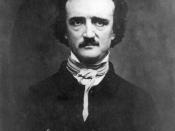In Edgar Allan Poe's short story, "The Tell-Tale Heart," the narrator tries to convince the reader that he is not mad. At the very beginning of the story, he asks, "...why will you say I am mad?" When the storyteller tells his story, it's obvious why he's mad through the use of literary elements and techniques. He attempts to tell his story in a calm manner, but occasionally jumps into a furious rage. The Tell-Tale Heart reveals through use of various literary elements and techniques the inner conflict, the state of madness, and emotional breakdown that one's mind can inflict upon itself.
The irony in the story is in the second sentence of the first paragraph; the narrator says, "The disease had sharpened my senses-- not destroyed, not dulled them."(p. 151). The reason this is ironic is because he believed that his insanity was an advantage to his situation, when really it lead to his ruin.
If he weren't so positive that his plan would be completely flawless because of his "heightened senses", he would have never ended up getting caught or admitted to the police that he killed the old man.
Symbolism also plays an important role in the story. It illustrates the emotional breakdown of the character through the major symbol used in within the story, the heartbeat. The narrator believed that the sound was the beating of the old man's heart, but it was actually his own heartbeat, signifying his fear of getting caught, and his guilty conscience tormenting him for killing the old man. The old man's eye obviously represents evil and it was the same evil in the old man's eye t that the narrator was trying to destroy.
Through the use of literary elements and techniques Poe creates a mentally ill state...


